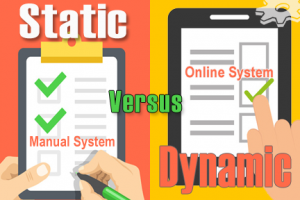 As small business owners wisely seek to grow by implementing well-designed process management systems, it’s important to understand the difference: Static Systems versus Dynamic Systems…
As small business owners wisely seek to grow by implementing well-designed process management systems, it’s important to understand the difference: Static Systems versus Dynamic Systems…
STATIC SYSTEMS lack movement. Fixed by design; often viewed as out-of-fashion, monotonous or uninteresting. Examples of these types of systems, for our purpose, include manual business forms, paperback books, manual time sheets, cork bulletin boards, etc.
DYNAMIC SYSTEMS change states. Interactive; they must change states to be useful. These types of systems include software, apps, computers, digital bulletin boards, and mobile phones, etc.
Definition of A System
As defined in this article, a SYSTEM is an orderly method, procedure or design; a collection or arrangement of parts, facts, and documents, etc., that relate to or interact with each other, in such a way as to form a whole.
Therefore, in this article, we will concentrate on a type of business system that operates and runs a business.
Dynamic Systems Are Better for Business | Even Fun!
Most companies function with business documents that are static; usually filled-out manually, i.e. a FORM. In addition, other business documents, i.e. policies and procedure, are usually, also static documents. In fact, most ISO (International Standards Organization) companies’ documents are manual static documents. Likewise, the maintenance of the ISO documents is a STATIC document management system, i.e. 3-Ring Binders. Boring!
When we first began to systemize our business, using a written Operations Manual, it was totally manual/static; Document Management using Excel, and Static Documents using Word, PDF’s and Quark.
We soon discovered, managing STATIC SYSTEMS can be challenging, not to mention grueling and tedious. But, make no mistake here, even STATIC SYSTEMS work!
Having said that, I know from my coaching experience with small business owners, that managing static systems is something most of them WILL NOT do. They claim they just don’t have the time!
OK, that’s where DYNAMIC SYSTEMS comes into play, because they are much easier to sustain. Even more interesting, and as my wife says, they can be FUN!
Consider the following, when filling out a form on a website like Amazon, i.e. to order a book. In short, this is a Dynamic System. The reason its Dynamic is, it’s interactive; changes made easily, easy to access and use. And it has an administration side for Amazon’s management, etc.
In like manner, imagine all documents in your business being DYNAMIC versus STATIC.
A Dynamic System to Create a Dynamic System for Business
The future of software will continue to empower users to make changes, updates, and to customize software solutions. All this, without need of a programmer or asking for enhancements from the software developer!
With that in mind, when I started developing our software in 2003, I tried to look ten years into the future. I could envision a software that was totally DYNAMIC, browser and subscription based. We made the right decision to develop that software.
The FEATURE I’m most proud of is, the System to Create a System from scratch in a matter of a few minutes, without need of a programmer. Now that’s DYNAMIC on steroids!
Whenever you look to purchase a BMP (Business Process management), ERP, or MIS system, I suggest you investigate its dynamism, in the context of this article.
Did I mention? Great Dynamic Systems Work!

Recent Comments